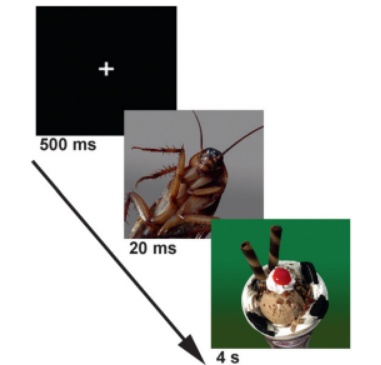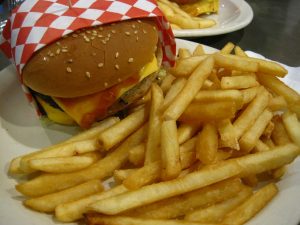 I recently came across an interesting paper in the American Journal of Clinical Nutrition that I felt was worth covering in some detail. The study involved using negative and positive imagery with high calorie and low calorie foods, respectively, in order to ‘alter responses to visual food cues’. This means that certain foods were associated with imagery that was perceived as negative and some positive, with all images taken from a database of such negative and positive images (used for research purposes such as this). The method of the study consisted of the subjects being shown a series of pictures of food (both high and low calorie) and being asked to rate the foods on a scale that represented the desirability to consume them. The subjects were then split into two groups and one group simply repeated this protocol. However, the other group were shown the negative pictures alongside the high calorie food pictures and positive pictures alongside the low calorie pictures while rating them based on their desire to consume them.
I recently came across an interesting paper in the American Journal of Clinical Nutrition that I felt was worth covering in some detail. The study involved using negative and positive imagery with high calorie and low calorie foods, respectively, in order to ‘alter responses to visual food cues’. This means that certain foods were associated with imagery that was perceived as negative and some positive, with all images taken from a database of such negative and positive images (used for research purposes such as this). The method of the study consisted of the subjects being shown a series of pictures of food (both high and low calorie) and being asked to rate the foods on a scale that represented the desirability to consume them. The subjects were then split into two groups and one group simply repeated this protocol. However, the other group were shown the negative pictures alongside the high calorie food pictures and positive pictures alongside the low calorie pictures while rating them based on their desire to consume them.

An example of the negative imagery used in the study. Subjects were shown a blank screen with a cross, followed by the negative imagery, and then the high calorie food. The negative image was only visible for 20 ms, beyond the ability of humans to perceive the image consciously.
The interesting point about these negative and positive images was that they were not knowingly seen by the subjects. The negative images were placed into the imagery of the food only very briefly, disappearing from view more quickly that the perceivable visual range (around 20 ms). Therefore although the imagery had entered the subconscious of the individuals, they were unaware what they had seen these negative or positive images (although they were told they would be shown negative and positive images, none of the subjects could identify the images when asked). The negative imagery included a cockroach, another showed vomit in a lavatory, another a broken bone, another a burn wound on skin. Positive imagery included kittens, a baby smiling, a butterfly on a flower and a couple smiling. The main result of the study showed that when negative imagery was shown with high calorie foods, the desirability of those foods fell, suggesting that the negative imagery had indeed altered the desirability of the food.

Could subconscious imagery be used in advertising for foods such as this in order to increase their consumption?
However, more interestingly, the desirability of other high calorie foods also fell in the subjects who had been shown negative imagery. This suggests that the effects of the negative imagery on the desirability of the food was not specific to the images shown, but a general effect that encompassed all high calorie foods. In addition this effect persisted to when the subjects were retested some days later. This study therefore shows what I have suspected for some time, and that is is possible to use imagery placed into the subconscious to change the desires of the individual without them being aware of the subversion. This throws up a number of questions about food advertising and whether they currently use similar tricks to increase the sale of their low quality foods. If negative imagery can be used to reduce the intake of high calorie foods, can positive imagery be used to increase their desirability? In this study the positive imagery was not tested with high calorie foods, and so it is not possible to say what would happen.
Eat Well, Protect Yourself.
RdB
